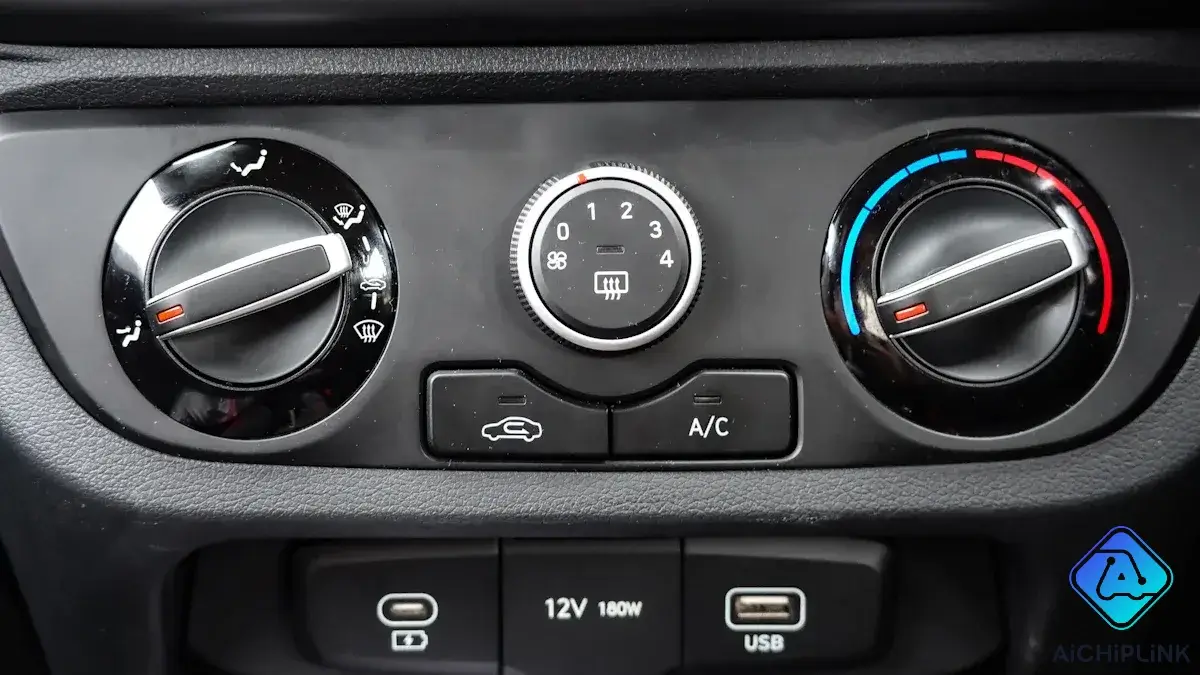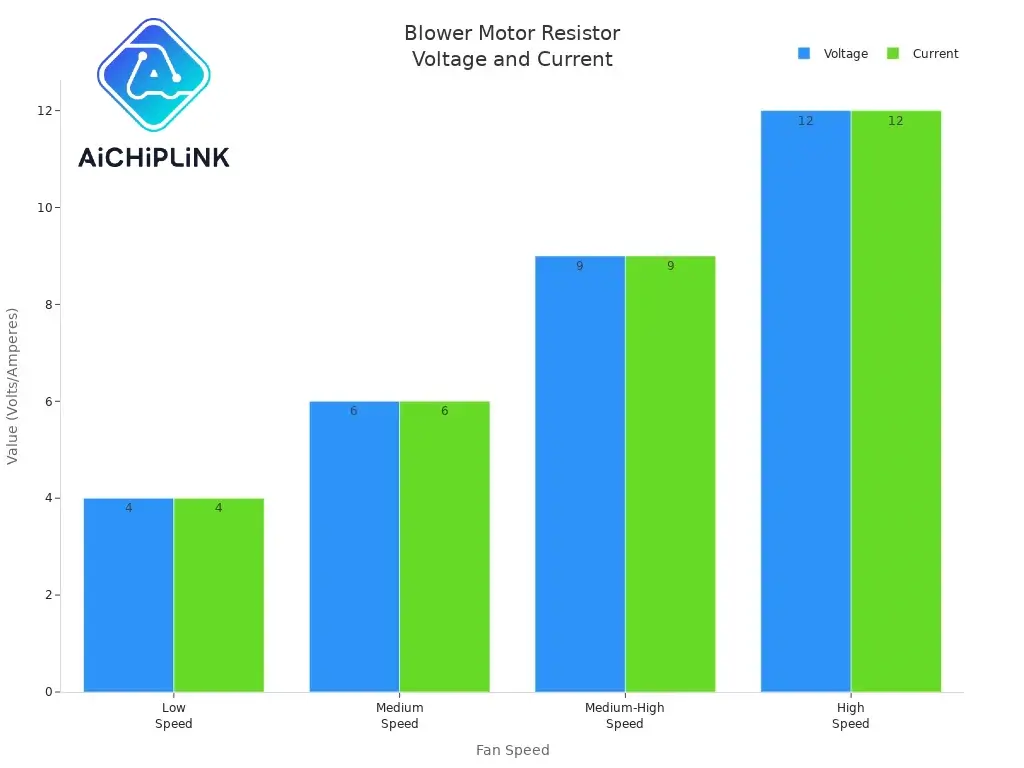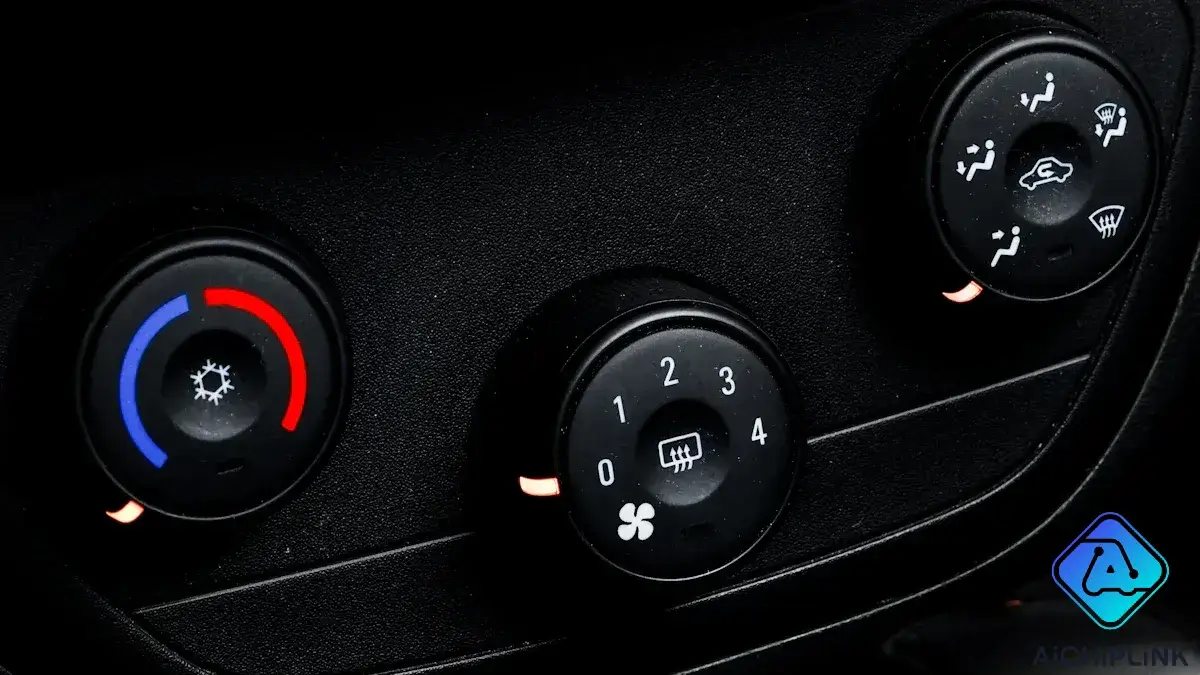
A blower motor resistor controls how fast air moves in your car. You use the blower when you change the fan speed in your HVAC system. The blower motor resistor changes the speed by changing electrical resistance. This lets you choose the airflow that feels best for you. Modern cars use this part to give you more control over temperature and comfort. Automatic HVAC systems use the blower motor resistor and sensors to keep the air just right. This saves energy and makes your ride smoother. You need the blower for heat in winter and cool air in summer. A working blower motor resistor keeps your drives comfortable.
Key Takeaways
-
The blower motor resistor changes your car’s fan speed by changing how much electricity flows. This lets you pick the airflow that keeps you comfortable.
-
If the blower motor resistor is bad, your fan may only work on high speed or not work at all. This can make the air in your car too hot or too cold.
-
You can check if the resistor is broken by testing the fan speeds and looking at the fuse. You can replace it yourself with simple tools and by following safety rules.
-
If you ignore a bad resistor, it can hurt your HVAC system. It can also cause problems like smoke or make it hard to see out your windshield.
-
Fixing or changing the blower motor resistor gives you full control of your car’s heating and cooling. This makes every drive more comfortable and safe.
Blower Motor Resistor Function
Fan Speed Control
You control the comfort inside your car by adjusting the fan speed on your HVAC system. The blower motor resistor makes this possible. When you turn the fan knob or press the fan button, the resistor changes the amount of electrical resistance in the circuit. This action changes how much power reaches the blower. More resistance means less power, so the fan spins slower. Less resistance lets more power through, making the fan spin faster.
-
The blower motor resistor regulates the electrical current flowing to the blower fan.
-
Higher resistance results in lower fan speeds.
-
Lower resistance allows higher fan speeds.
-
The resistor provides multiple fan speed settings.
-
Without the resistor, the blower would only run at one speed, usually the highest.
You can see how the resistor changes the voltage and current at each fan speed in the table below:
| Fan Speed | Electrical Path Description | Voltage (Volts) | Current (Amperes) |
|---|---|---|---|
| Low Speed | Current flows through three resistors | ~4 | ~4 |
| Medium Speed | Current flows through two resistors | ~6 | ~6 |
| Medium-High Speed | Current flows through one resistor | ~9 | ~9 |
| High Speed | Full battery voltage through a relay (bypasses resistor) | ~12 | ~12 |

When you select a lower fan speed, the blower motor resistor increases resistance. This reduces the voltage and current, so the blower turns slower. At the highest setting, the resistor gets bypassed, and the blower receives full power. If the resistor fails, you might notice the fan only works on high or not at all.
Airflow and Comfort
The blower motor resistor does more than just control the fan speed. It also affects how much airflow moves through your vents. When you set the fan to low, the resistor slows the blower, and you get gentle airflow. If you want more airflow, you increase the fan speed, and the resistor lets more power reach the blower. This gives you stronger airflow and helps you cool or heat the cabin faster.
-
The resistor controls the electrical current to the blower, which changes the airflow.
-
More resistance slows the fan, reducing airflow.
-
Less resistance speeds up the fan, increasing airflow.
-
The resistor helps you control how much air moves through the vents.
-
A bad resistor can cause the fan to work only at the highest speed or not at all, leading to poor airflow.
You need good airflow for comfort and safety. In hot weather, strong airflow from the blower helps the a/c cool the cabin quickly. In cold weather, you need warm airflow to stay comfortable and to clear fog or ice from the windshield. If the blower motor resistor fails, you lose control over airflow. This can make the a/c less effective and leave you uncomfortable during extreme weather.
Tip: If you notice weak airflow or the fan only works on one speed, the blower motor resistor might be the problem. Fixing it restores full control over your HVAC system and keeps your drives comfortable.
The blower motor resistor is a small part, but it plays a big role in your HVAC system. It lets you adjust fan speed and airflow, so you can stay comfortable no matter the weather.
How a Blower Motor Resistor Works
Electrical Resistance
You control the speed of your car’s fan with the blower motor resistor. This small part sits in the electrical circuit between the fan switch and the blower. When you select a fan speed, the blower motor resistor changes how much electricity flows to the blower. It does this by adding different amounts of resistance to the circuit.
When you pick a low fan speed, the blower motor resistor uses higher resistance. This reduces the current and voltage that reach the blower. The fan spins slower, and you get gentle airflow through the vents. If you want more airflow, you turn up the fan. The blower motor resistor then lowers its resistance, letting more current reach the blower. The fan spins faster, and you feel stronger airflow.
At the highest fan speed, the blower motor resistor gets bypassed. The blower receives full voltage and spins at its fastest. This setup gives you smooth control over airflow and helps protect the blower from too much current. The resistor also heats up during use, so it sits in the airflow duct to stay cool.
Note: Some blower motor resistors include a thermistor. This extra part helps prevent the blower from overheating by reducing current if things get too hot.
HVAC System Integration
The blower motor resistor works closely with other parts of your hvac system. You find it connected in series with the blower and the fan speed switch. This setup lets you adjust airflow easily from your dashboard.
-
The blower motor resistor sits near the blower, often behind the dashboard on the passenger side.
-
It controls the electrical current to the blower, changing airflow as you adjust the fan speed.
-
At lower speeds, it adds resistance to slow the blower and reduce airflow.
-
At higher speeds, it lowers resistance, giving you more airflow.
-
At the highest setting, the resistor is bypassed, and the blower gets full power.
The resistor’s location in the airflow duct helps it stay cool, even when it generates heat at low speeds. This design keeps your hvac system running smoothly and protects the blower from damage. You get steady airflow and reliable comfort, no matter the weather.
Tip: If you notice the fan only works on high or you lose control over airflow, the blower motor resistor may need attention. Keeping it in good shape helps your hvac system last longer.
Signs of a Bad Blower Motor Resistor

When your car’s HVAC system starts acting up, you might notice some clear signs of a bad blower motor resistor. This small part can cause big problems with your comfort and safety. Knowing what to look for helps you spot trouble early and avoid a total hvac system malfunction.
Loss of Fan Speeds
One of the most common signs of a bad blower motor resistor is the loss of certain fan speeds. You may find that your fan only works at one or two settings, or it skips some speeds entirely. This happens because the resistor controls how much power reaches the blower at each speed. When it fails, you lose control over the fan.
-
The fan might work on high but not on low or medium.
-
Sometimes, the blower only works at the lowest speed.
-
You may notice the blower speed stays the same, no matter how you adjust the knob.
This problem often starts with the resistor’s internal fuse blowing. If your blower motor has worn bearings or draws too much current, it can overheat the resistor and cause it to fail. Loose or corroded connections can also interrupt power at certain speeds, making it look like the resistor is bad.
Tip: If you lose control over your fan speeds, check the blower motor resistor first. But also inspect the blower motor itself, as a faulty motor can cause repeated resistor failures.
Inconsistent Airflow
Another warning sign is inconsistent airflow from your vents. You might notice the blower fan works sometimes but not always. The air may come out strong one moment and weak the next. In some cases, you get no air flow at all, even when the fan is on.
-
The blower fan may only work at certain settings.
-
Sometimes, you get no air coming from vents.
-
The airflow can change without you touching the controls.
These symptoms happen because the blower motor resistor regulates power to the blower. When it fails, it can cut power completely or only let some power through. Many drivers confuse these issues with a bad fan switch, but the resistor is often the real cause. If you notice loss of hvac fan control or inconsistent airflow, the resistor could be to blame.
Note: Unusual noises, like rattling or screeching, and burning smells can also point to a bad blower motor resistor. Overheating can even cause smoke in rare cases.
Fan Only Works on High
A classic sign of a bad blower motor resistor is when the fan only works on the highest setting. This happens because the high-speed setting bypasses the resistor and sends full power straight to the blower. If the resistor fails, all lower speeds stop working, but high speed still works.
-
The blower runs at full blast, even if you set it to low or medium.
-
Lower fan speeds do nothing, but high speed works every time.
-
This issue is common in many vehicles and points directly to the blower motor resistor.
If you notice your fan only works on high, you should check the resistor right away. A worn blower motor can cause this problem by drawing too much current and damaging the resistor. Always test the blower motor’s amp draw to prevent future failures.
🚗 Quick Check: If your fan only blasts on high, you likely have a bad blower motor resistor. Fixing it restores full control over your HVAC system and keeps you comfortable in any weather.
Knowing the signs of a bad blower motor resistor helps you act fast. You can avoid bigger problems and keep your car’s HVAC system running smoothly.
Replace a Blower Motor Resistor
Diagnosis Steps
You can check if your blower motor resistor is bad by following some easy steps. First, find the fuse for the blower motor resistor in your car. Use a 12V test light to see if both sides of the fuse have power. If the fuse works, unplug the power from the resistor. Then, try changing the blower speeds on your dashboard. If you lose power at low speeds but get it back at high speed, the resistor is probably broken. Always look at the blower motor’s ground connection too. A bad ground can cause the same problems.
-
Find the blower motor resistor fuse.
-
Use a 12V test light to check the fuse.
-
Unplug the power and test the blower speeds.
-
Look at the blower motor’s ground.
Tip: If you have power at high speed but not at lower speeds, you likely need a new resistor.
Replacement Process
You can usually change a blower motor resistor yourself if you have basic tools and follow safety rules. Get screwdrivers, a socket wrench set, a multimeter, a flashlight, and the right resistor for your car. Always take off the car battery before you start so you do not get shocked. Wear gloves to keep your hands safe. Use a flashlight to see under the dashboard, where the resistor is close to the blower.
-
Take off covers and screws with the right tools.
-
Unplug the wires from the old resistor.
-
Put in the new resistor and use dielectric grease on the connections.
-
Plug the wires back in and make sure the resistor is tight.
-
Test the blower to see if all the speeds work.
If you do not install it right, you could get overheating, melted connectors, or even electrical problems. Always use tight connectors and keep your parts in order. If you skip steps or hurry, you might only have high speed or break the new resistor.
When to Get Help
Some cars make it hard to reach the resistor, or you might have electrical problems like short circuits or rust. If you are not sure what to do, ask a professional for help. Experts can find tough problems, give you a warranty, and make sure the repair is safe. Getting a pro to replace the resistor costs less than fixing the whole blower motor, usually between $135 and $186, but a new blower motor costs a lot more. Many parts have a short warranty, but some stores give longer ones. Always check your warranty before you change a blower motor resistor.
Note: If you do not have the right tools or know-how, a professional can save you time and help you avoid expensive mistakes.
A working blower motor resistor keeps you comfortable and safe on the road. If you ignore warning signs, you risk smoke, burning smells, or even fire hazards. You also lose control over airflow, which can make it hard to see through your windshield in bad weather.
-
Timely repairs help your HVAC system last longer and prevent costly damage.
-
Replace air filters often and keep vents clean to protect the resistor.
-
If you notice strange smells or airflow problems, act quickly to avoid bigger issues.
Stay alert to changes in your car’s HVAC system. Quick action protects you and your vehicle.
FAQ
What happens if you ignore a bad blower motor resistor?
If you ignore a bad resistor, you lose control over your fan speeds. You might get stuck with weak airflow or only high speed. This can make driving uncomfortable and unsafe, especially in extreme weather.
Can you drive your car with a faulty blower motor resistor?
You can drive your car, but you may not get proper airflow for heating or cooling. This can make it hard to clear your windshield or stay comfortable. Fixing the resistor keeps your HVAC system working right.
How long does a blower motor resistor last?
Most blower motor resistors last several years. Heat, moisture, or a worn blower motor can shorten its life. If you notice fan speed problems, check the resistor soon.
Is replacing a blower motor resistor expensive?
Most replacements cost between $135 and $186, including parts and labor. Doing it yourself can save money. Always use the correct part for your car to avoid future problems.
Written by Jack Elliott from AIChipLink.
AIChipLink, one of the fastest-growing global independent electronic components distributors in the world, offers millions of products from thousands of manufacturers, and many of our in-stock parts is available to ship same day.
We mainly source and distribute integrated circuit (IC) products of brands such as Broadcom, Microchip, Texas Instruments, Infineon, NXP, Analog Devices, Qualcomm, Intel, etc., which are widely used in communication & network, telecom, industrial control, new energy and automotive electronics.
Empowered by AI, Linked to the Future. Get started on AIChipLink.com and submit your RFQ online today!




